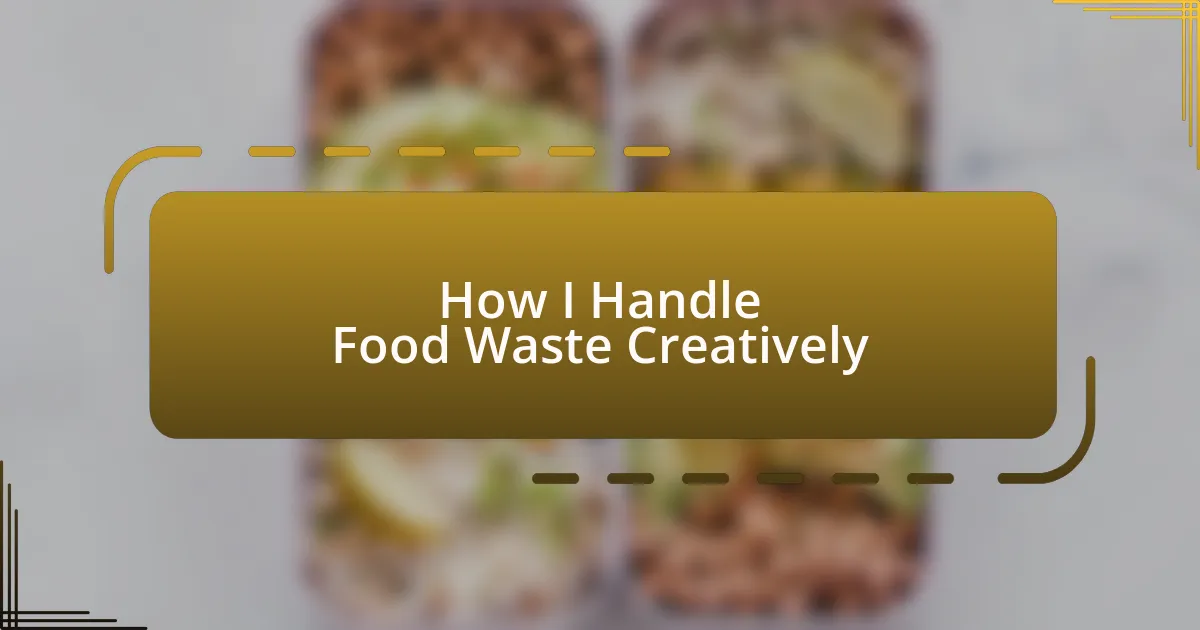Key takeaways:
- Nearly one-third of global food production is wasted; awareness can lead to responsible consumption habits.
- Innovative repurposing of leftovers, such as transforming roasted vegetables into frittatas, enhances meals and reduces waste.
- Mindful shopping practices, including making detailed grocery lists and choosing bulk options, can significantly minimize food waste and save money.
- Paying attention to seasonal produce offers fresher, more flavorful ingredients while being cost-effective.
Author: Clara Whitfield
Bio: Clara Whitfield is an award-winning author known for her evocative storytelling and rich character development. With a background in literature and a passion for exploring the intricacies of human relationships, Clara has published several novels that delve into the complexities of love, loss, and personal growth. Her work has garnered critical acclaim and a loyal readership, earning her nominations for prestigious literary awards. When she’s not writing, Clara enjoys hiking, painting, and sharing her insights on the craft of writing through workshops and online platforms. She resides in the Pacific Northwest with her family and a spirited rescue dog named Luna.
Understanding food waste importance
Understanding the importance of food waste is essential in our increasingly consumer-driven society. When I first became aware of how much food is discarded – nearly a third of all food produced globally – it struck a personal chord. Imagine standing in your kitchen and realizing that every leftover you’ve thrown away contributes to this staggering statistic; it compels you to rethink your habits.
Reflecting on my own experiences, I remember a time when I regularly tossed produce that had seen better days. It wasn’t just about the financial aspect, though that weighed heavily on my mind. I began to feel a deeper sense of responsibility for the resources wasted and the environmental impact associated with food disposal. If I could reduce my waste even slightly, wouldn’t that contribute to a larger change?
Engaging with the issue of food waste isn’t just about numbers; it’s about valuing the effort that goes into food production. Each meal represents a story, doesn’t it? From the farmers who cultivate the crops to the chefs who prepare them, every stage deserves respect. So, how can we make the most of our food and minimize waste? That question has driven many creative solutions in my kitchen, where I’ve found joy in repurposing what might ordinarily be discarded.
Repurposing leftovers in new dishes
Finding innovative ways to repurpose leftovers has transformed my cooking experience. For instance, I often turn last night’s roasted vegetables into a flavorful frittata. It’s fascinating how a few eggs and some herbs can breathe new life into what’s left on my plate. Have you ever tried this? It not only reduces waste but also adds variety to my meal plans.
Another favorite of mine is using stale bread for homemade croutons. A simple toss with olive oil and seasoning can turn something I might have tossed into a delicious garnish for soups and salads. It’s like having a secret weapon in my pantry that enhances my dishes while embracing sustainability. Don’t you think it’s exciting to create something valuable out of what once felt like excess?
I also love experimenting with sauces and dressings that can utilize nearly empty jars of condiments in my fridge. Think about combining mustard, leftover pickles, and herbs to whip up a zesty potato salad. This approach not only sparks creativity in the kitchen but also fosters a sense of accomplishment. There’s something undeniably rewarding about transforming leftovers into new culinary adventures. Have you felt that spark of inspiration when creating meals from what’s already there?
Tips for mindful shopping habits
When it comes to mindful shopping, one of my go-to strategies is making a detailed grocery list before heading to the store. I find that this not only helps me stick to my budget but also significantly reduces impulse buys. Have you ever wandered down the aisles, tempted by shiny packaging and deals? I know I have, but now I focus on what I truly need, which cuts down on both food waste and overspending.
Another tip I swear by is choosing the bulk option whenever possible. Recently, I started buying grains and legumes in larger quantities from a local bulk store. It felt great to bring home my reusable bags filled with only what I needed. Not only do I save money in the long run, but it also reduces the amount of packaging waste. Have you considered this option? It’s a simple change that packs a powerful punch in both sustainability and cost-saving.
Additionally, I’ve learned to pay attention to seasonal produce. Shopping for fruits and vegetables that are in season not only enhances the flavors of my dishes but also often leads to fresher and more affordable options. I remember the first time I bought strawberries in the winter – they were tasteless and disappointing. Now, when I keep my eye on what’s in season, I enjoy ingredients that are at their peak and feel more connected to the food I prepare. Does that resonate with your experiences in the kitchen?

Leave a Reply